
Recovering mountaineer Norman Hadley ponders the many, varied, and often ludicrous ways to get into a pickle in the snow.
With the winter climbing season in full swing, it seems a good time to reflect on the perils and pitfalls that await the rash and unwary in the snowy hills. Here are some of the sillier scrapes I've got into over the years.
The sharper-eyed among you will harrumph that I've merely cobbled together an article from a disparate series of "there was this one time" mishaps and follies. Guilty as charged. The really sharp among you will spot what's really important here: you won't get a better opportunity to regale us with your own anecdotes in the comments section. I'm sure you lot have many a tap-room tale up your sleeves, so let's hear 'em.
Post-hole exhaustion
"Post-holing" might sound like the kind of sexual depravity you accidentally discover on Urban Dictionary. But it merely describes the awkward, high stepping gait required for deep snow. When only thigh-deep, you can make reasonable progress with a Monty Python-style Silly Walk, and you might hope to get to the foot of your route without the inconvenience of cardiac arrest.
Deeper snow is a whole other level of fun. A bunch of us decided to head up Gleann na Sguaib for a somewhat quixotic look-see at Penguin Gully. The Scottish skies had dumped about a metre and half of fresh snow into the glen: well up to chest height on the tallest of us. I'd made the tactical blunder of being the youngest in the party by some margin, so was unanimously appointed Trail Blazer. I was pretty flexible back then, but there was no way I could step a metre and a half high. I experimented with assorted swimming strokes, but they all proved futile.
It turned out the only strategy for making headway was to deliberately fall face down, arms raised. Then I could stand up and walk forward in the newly-compacted eight-foot trench. And repeat. For mile after exhausting mile. Needless to say, the final approach slope to Penguin Gully was completely unjustifiable, so we headed back empty-handed. At least we had a convenient trench to make good our retreat.
P.S. I once told this story to a woman who remarked that the experience would have been so much simpler with snowshoes. But where would the fun have been then, Sensible Lady? How would I have wrought an anecdote from that?
Fear and loathing in Lakes-vegas
Anyone who's read about the glory days, when Robin Smith and Jimmy Marshall could put up half a dozen new routes in a week, will be acutely aware of the effect of global warming on the sport. One particular winter had proved especially dispiriting, with barely any snow or ice to be found in the Lakes. In a fit of unreasoning optimism, I headed up to the hollows of Dollywaggon Pike, in search of sport. Nothing. Not enough ice to cool a martini.
Petulantly, I decided to have a crack at a route anyway. I set off up a dark gash, reaching a bridgeable chimney beneath a chockstone. With crampons scratching for purchase, I back-and-footed up to the chockstone and reached a hopeful arm over the top, fumbling for a jug that I felt sure would haul me up. It was so mild there was no need for gloves and the texture I encountered surprised me. What was that? It was damp but didn't feel like wet moss. It wasn't rock and it sure as hell wasn't ice.
But it was something. With my front-points starting to skitter on the bare rock walls, I sank my fingers in as deep as they'd go and hauled myself over the chockstone. It was at this point that I came eye-level with a sheep. A sheep that had had better days. A sheep that had evidently strayed too far in search of a dainty tuft of herbs and plummeted down the gully to a rather messy end. I now understood the texture of my handhold to have been a mixture of wet wool, ribs and past-its-sell-by-date offal.
Misadventure by space-walk
I'd been staying at the CIC hut, and a couple of us had enjoyed a pleasant day's climbing round Coire na Ciste. The wind had been getting steadily stronger, but one gets inured after a while. My partner had (perhaps wisely) decided to return to the warmth of the hut, but I had an appetite for one more gully. That's what they say on the crummiest cop shows, right? "One more case and I hand in my badge, sarge." I selected something eminently soloable: North Gully. My rucksack was heavy with ropes and gear, so it seemed sensible to cache it in the corrie and collect it on the way down. For the first ninety-five percent of the route, this strategy proved sound.
It was only when I reached the cornice that I realised the absence of a rucksack meant a) I was somewhat lighter than before and b) the absence of a waist belt had radically changed my aerodynamic characteristics. The north wind was slamming into the face square-on and being deflected upward, ballooning my cag into the shape of a prototype Dryrobe. Steadily, as I crept higher, I lightened until the critical point at which I became gravity-neutral. Nowadays, you can pay for this sensation in one of those skydiving wind-tunnels.
I held my position, wondering what to do. Let go, and hope the wind would miraculously draw me up in a sinuous S-shape and deposit me on the plateau? But it could just as easily curl back like a surfer's wave and spit me back into space over the corrie. Not even Wile E Coyote was going to survive that. Think, man, think. If you're weightless, you need to invert customary ways of thinking. You're no longer holding yourself up but down. So you need to lower yourself up. That's how I found myself jamming in door-posts facing upward, tethering me to Earth. Arm over arm, I let myself be carried the last few metres until the final relieved flop onto the plateau.
Megaloceros attack
Descending from the whited-out Cairngorms one day, I emerged from the clag into Strath Nethy. The snow was deep enough that it covered the burn, smoothing out the glen into a pristine bowl as white as anything Royal Doulton ever fashioned. As I descended, I could dimly make out a herd of Strange Beasts lower down. They were so pale as to blend in with their snowy surroundings. What the hell could they be? If you've ever wandered the Cairngorm plateau after a sleepless bivy, you'll know how perceptions can become distorted. If Loch Ness could hide a plesiosaur in its black depths, could giant elk, left over from the Pleistocene, still be roaming these hills?
As I came closer, it became apparent they were reindeer. This was my first time seeing them and I had no idea what to expect. How big would they be? How friendly would they be? Such questions became increasingly urgent as they approached me with mounting curiosity. It seemed that my arrival was the most interesting thing to have happened to them for a while.
I then had a retinue of hairy beasts sniffing hungrily at me. You guys are vegetarian, right? Other questions came to the surface: who would win in a fight between one mountaineer and two dozen reindeer? It probably wouldn't come to that but, just in case, I made good my escape via a snow bridge too precarious for their hooves.
The misadventure of inadvertent bondage
I've long been fascinated by the noble art of roped soloing. As a teenager, I'd read and re-read tales of Pete Livesey climbing silly E-numbers on his tod, and wondered if the technique could be adapted to winter. That's how I found myself at dawn beneath a Lochnagar ice-pitch, with nobody else around. But I'd come armed with a ten-metre rope, a harness and a deadman. Whereas roped soloing rock involves complicated yo-yoing to retrieve gear, my Cunning Plan was that the deadman would make reversal unnecessary.
I hammered it in below the icefall and paused, my throat dry. The corrie was still emptier than a pauper's pocket. I gave the deadman an extra clobber, just to be sure, and tied on. The pitch was perhaps eight metres high, so I congratulated myself at the top on the judiciousness of my rope allowance. The deadman, a bomproof protection when pulled from below, would surely ease gently out of its slot when pulled from above. Alas, that final hammering, plus the intervening minutes of frost, had me straining against the rope as if there were literally a dead man at the bottom. Like a cartoon character snagged on his braces, it felt as if I was about to be catapulted back to the corrie floor. Luckily, the deadman blinked first, so I gratefully hauled anchor and easily soloed the rest of the route.
Aerial attack
I was out on my own one ferociously windy night, when the forecast was deploying phrases like "mobility will be tortuous". I was already at a half-crouch, headtorch glaring into the storm, when I got that prickly-necked sense of Something moving through the darkness. Something very fast. Something so fast it could only be a fighter jet, streaking across the terrain at a whisker under Mach One, so low I was about to be decapitated by a wing-tip.
The next sensation was of being hit very hard. But the impact was in the stomach rather than the head. I shone the torch down to see a rather dazed grouse rolling round in the heather. The poor creature, sent into moth-like confusion by the brightness of my head-torch, must have taken wing, only to be hurtled downwind at the kind of speed they fire chickens into jet engines. And my ribs had stood in for the turbine blades. Thankfully, I escaped with just a light winding. I can't vouch for the fate of the grouse.
Dodging a steamroller
Scottish avalanches have been a huge problem ever since Blyth Wright invented them in the eighties. The powdery ones, running down your neck as you swim up Point Five Gully, are usually just a mild discomfort. It's the wind-slabby ones that are properly scary. On this occasion, things turned distinctly ludicrous when a big slab slid away high above me in Coire na Ciste. I braced myself, scanning my options for running left or right. The slab got faster and faster, racing towards me, when it did something I hadn't anticipated at all. Tobogganing over a slight bump, the wind got underneath it. I watched as this plate of snow, perhaps half a metre thick, rose into the air like a slo-mo tossed pancake.
Unlike a pancake, it landed not upside-down but on its edge. Now it was no longer a slab but a colossal ferris wheel, uninhibited by friction. The act of rolling quickly knocked off all edges, making a disc of about five metres diameter, like the kind of peril Indiana Jones would have to dodge on entering a sacred tomb. I dived left and the thing missed me, bouncing off the little row of crags at the foot of the corrie, smashing itself to pieces before it could hit the CIC hut.
Buried alive
One of the first lessons I learned about mountains was the benefit of a microclimate. As soon as we reached a summit, Dad would lead us a few paces downwind in search of a sheltered lunch spot. It was incredible how much cosier it felt in the lee of a rock or dry-stone wall.
Fast forward a few years and I started bivvying out in winter, constantly searching for the most extreme situations. The top of the Cairngorm plateau was a favourite, if by "favourite" you mean sharing a bivy bag with ten kilograms of spindrift and the subsequent puddle of melt.
One of my worst bivvies wasn't even that high up. A couple of us had walked in to Lochnagar on a Friday night and laid out our beds just downwind of a car-sized boulder. Unfortunately, Dad's "find the lee" ethos was also shared by every single snowflake in the whole corrie. All night, the wind deposited great bucketloads of snow over us. Every ten minutes or so, a great wriggle would be needed to shake it off, lest we end up six feet under. Blummin' marvellous.
The over-application of geometric principles
Gritstone climbers habitually contort into shapes rarely seen outside a Hieronymous Bosch painting and winter climbing can get even more bizarre, especially in the final pitch as you grovel, writhe, tunnel and swim up the cornice. At this stage, when the sunlight on the crest is almost within arms's reach, the prospect of retreat down a dark, thousand-foot wall of ice tempts you to take risks you'd never countenance lower down. One of my oddest top-outs was on Number Two Gully Buttress on Ben Nevis. It was thickly plastered, I was soloing, and I was quite probably off-route, because it felt way harder than the grade.
The cornice gave me a menacing cobra-stare but I wasn't yet ready to consider a down-climb. Exploratory reaching revealed the snow was far too soft to hold a pick. So I improvised. I shoved both axe-shafts in and wiggled them. They seemed solid enough. Step up, shove the shafts in a little higher. This felt silly but not yet too silly. Wait, the cornice was about to fix that by getting steeper still. Like the famous frog in slowly heating water, my risk-appetite adjusted. Although the snow was unclimbably steep, a giant fluting ran straight down the middle. A mathematician to my bones, I figured the compound angles thus formed might make the difference between victory and the Other Thing. And that's how it suddenly seemed the least-worst option to perform a layback on door-posts. Incredibly it worked.
Bike vs ski - who's going to win that one?
I'd gone up for a spot of winter sport on Helvellyn and had had the cunning ruse of going up onto the ridge by mountain bike. It seemed like there was room for another hybrid sport (bikeaneering, anyone?) and it certainly felt interesting front-pointing up steep snow with an axe in one hand and the other hand steadying the bike on my shoulders. But things got properly interesting when it came time to descend, because there were also skiers and parapentists standing about in the crisp late-afternoon sunshine. Now the parapentists had their own game: to stay aloft as long as possible. But the skiers were clearly about to launch themselves down the snow slope as fast as they could.
No words were said, but the situation developed with a kind of inevitability. As they prepared to push off, I stowed the ice hardware as safely as I could in the rucksack, clipped the pedals and gave them a bit of a Chris Hoy-ing. Gravity then took over, and the bike was seized in its icy grip, getting faster and faster. Halfway down, the front wheel hit a soft patch and I was shot over the handlebars as if from a circus cannon. Never mind, brush the snow off, jump back in the saddle, can't let the skiers win, off again. This time faster still, plumes of powder billowing in my wake. I reached the bottom awash with adrenaline but, crucially, uninjured. And, just as crucially, first.






















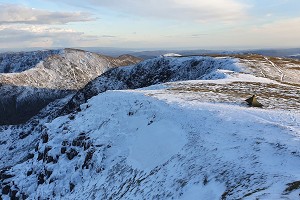
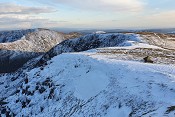
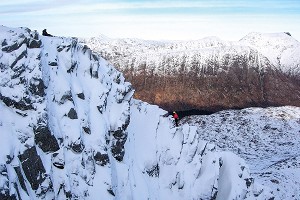
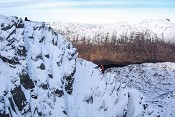


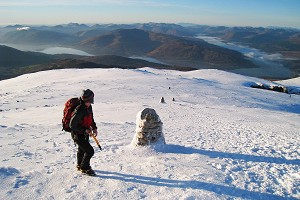
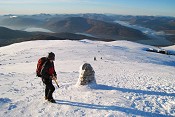
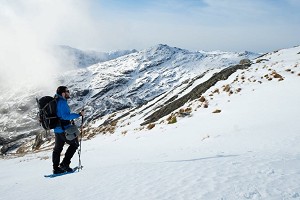
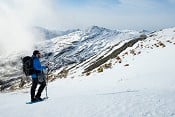
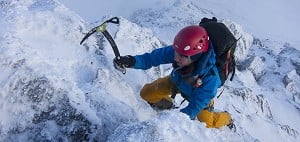

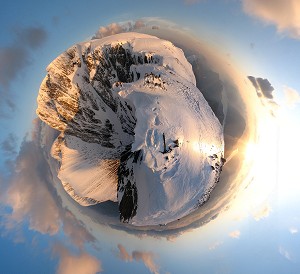
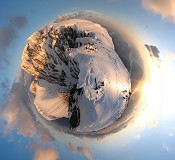





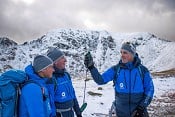
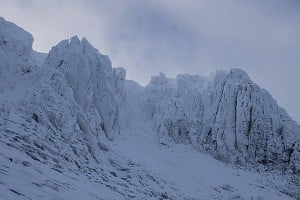
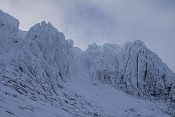
Comments
Thanks for the dead sheep story. I tend to enjoy my daily dip into UKC as I eat my lunch. I had just taken my first bite of microwaved quiche. Grateful it wasn't Lancashire Hot Pot I suppose!
Just be glad you're not haunted by a 🐑👻 for all eternity, John.
I'm sure there was a story on here, one time, about someone struggling for a belay in a gully one winter... They finally found something solid to sling: a sheep carcass, frozen into the snow...
I too was 'enjoying' lunch as I read the sheep bit...
Now if it had been frozen, that would have been a lot more pleasant. I might have taken it home and whacked it in the oven.